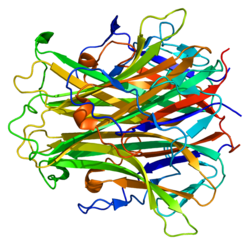
Back RANK-L Azerbaijani TNFSF11 Welsh RANK-Ligand German RANKL Spanish RANKL French RANKL Galician RANKL Polish RANKL Russian RANKL Serbo-Croatian RANKL Serbian
Receptor activator of nuclear factor kappa-Β ligand (RANKL), also known as tumor necrosis factor ligand superfamily member 11 (TNFSF11), TNF-related activation-induced cytokine (TRANCE), osteoprotegerin ligand (OPGL), and osteoclast differentiation factor (ODF), is a protein that in humans is encoded by the TNFSF11 gene.[5][6]
RANKL is known as a type II membrane protein and is a member of the tumor necrosis factor (TNF) superfamily.[7] RANKL has been identified to affect the immune system and control bone regeneration and remodeling. RANKL is an apoptosis regulator gene, a binding partner of osteoprotegerin (OPG), a ligand for the receptor RANK and controls cell proliferation by modifying protein levels of Id4, Id2 and cyclin D1.[8][9] RANKL is expressed in several tissues and organs including: skeletal muscle, thymus, liver, colon, small intestine, adrenal gland, osteoblast, mammary gland epithelial cells, prostate and pancreas.[9] Variation in concentration levels of RANKL throughout several organs reconfirms the importance of RANKL in tissue growth (particularly bone growth) and immune functions within the body.
- ^ a b c GRCh38: Ensembl release 89: ENSG00000120659 – Ensembl, May 2017
- ^ a b c GRCm38: Ensembl release 89: ENSMUSG00000022015 – Ensembl, May 2017
- ^ "Human PubMed Reference:". National Center for Biotechnology Information, U.S. National Library of Medicine.
- ^ "Mouse PubMed Reference:". National Center for Biotechnology Information, U.S. National Library of Medicine.
- ^ Wong BR, Rho J, Arron J, Robinson E, Orlinick J, Chao M, Kalachikov S, Cayani E, Bartlett FS, Frankel WN, Lee SY, Choi Y (October 1997). "TRANCE is a novel ligand of the tumor necrosis factor receptor family that activates c-Jun N-terminal kinase in T cells". J. Biol. Chem. 272 (40): 25190–4. doi:10.1074/jbc.272.40.25190. PMID 9312132.
- ^ Anderson DM, Maraskovsky E, Billingsley WL, Dougall WC, Tometsko ME, Roux ER, Teepe MC, DuBose RF, Cosman D, Galibert L (November 1997). "A homologue of the TNF receptor and its ligand enhance T-cell growth and dendritic-cell function". Nature. 390 (6656): 175–9. Bibcode:1997Natur.390..175A. doi:10.1038/36593. PMID 9367155. S2CID 4373990.
- ^ Hanada R, Hanada T, Sigl V, Schramek D, Penninger JM (2011). "RANKL/RANK-beyond bones". J. Mol. Med. 89 (7): 647–56. doi:10.1007/s00109-011-0749-z. PMID 21445556. S2CID 25285776.
- ^ Mueller CG, Hess E (2012). "Emerging Functions of RANKL in Lymphoid Tissues". Front Immunol. 3: 261. doi:10.3389/fimmu.2012.00261. PMC 3432452. PMID 22969763.
- ^ a b Wada T, Nakashima T, Hiroshi N, Penninger JM (2006). "RANKL-RANK signaling in osteoclastogenesis and bone disease". Trends Mol Med. 12 (1): 17–25. doi:10.1016/j.molmed.2005.11.007. PMID 16356770.
© MMXXIII Rich X Search. We shall prevail. All rights reserved. Rich X Search






